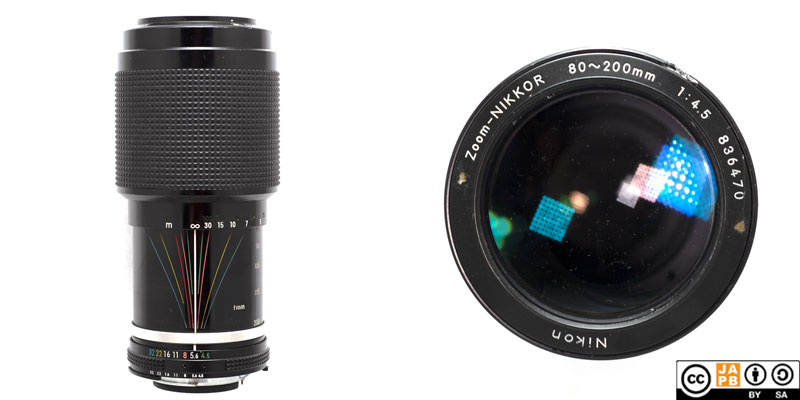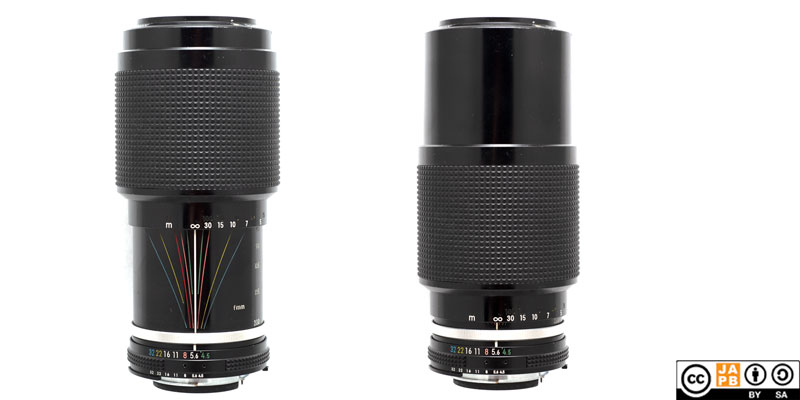Pekka Buttler, 12/2023

Specifications
The table below summarizes the lens’ key specifications (measurements based on pictured sample):
| Brand: | Nikon (Nikkor) | Lens name | Zoom-NIKKOR 80~200mm 1:4.5 |
| Focal length(s) 1 | 80–200 mm | Angle-of-view 2 | 30°10–12°20 |
| Maximum Aperture | f/4.5 | In Production | 1977–1981 |
| Lens mount | Nikon F | Subfamily (if applicable) | Ai (Automatic indexing) |
| Length 3 | 153,1 mm | Diameter 4 | 73,3 mm |
| Filter ring diameter | 52 mm | Weight | 744 grams |
| Lens element count | 12 | Lens group count | 9 |
| Aperture blades (S/R/C) 5 | 7 S | Focus throw | 180 ° |
| Minimum focusing distance | 1,8 metre | Maximum magnification | 1:7,4 |
| Has manual aperture ring | YES | Has Manual focus ring | YES |
| Aperture mechanism type | Automatic | Aperture click stops 6 | 4.5-5.6-8-11-16-22-32 |
Further notes:
• The lens is a one-ring zoom, meaning that the same rings controls zooming (forward–backward) and focusing (through rotation). In the case of this lens, you pull the zoom ring towards the camera to zoom in (toward 200 mm) and push the zoom ring away from the camera to zoom out (towards 80 mm).
• The whole front-part of the lens (including filter rings) rotate when focusing.
• The lens barrel offers intermediate focal length markings at 80, 90, 105, 135 and 200 mm and a beautiful multicoloured depth-of-field preview.
• The barrel length stays the same while zooming, but lengthens a bit when focusing towards MFD.
• Nikon offered a dedicated, thread-mounted lens hood for this lens (the HN-7)
• This lens shares identical mainline specifications (80-200 mm f/4.5) with four other Nikon lenses. See ‘versions‘ for a detailed breakdown.

Historical notes:
• When Nikon in November of 1959 introduced the 8,5–25cm tele zoom, it was the first Japanese zoom lens, the first tele zoom lens, and only the second zoom lens worldwide (for 35 mm photography).
• While professionals remained sceptical of standard zooms and especially tele zooms, the advantages offered by a tele zoom were so compelling that tele zooms became an instant hit, limited only by their rather high cost.
• By the time this lens was introduced, Nikon had 18 years of experience in producing tele zooms and Nikon had already produced ≈160 000 tele zoom lenses. In the next 4 years, Nikon would sell ≈150 000 copies of this lens alone. The real boom of tele zooms was only just beginning.
Versions
First, Nikon’s 60+ year history of offering of professional-oriented tele zooms can be divided into four ‘acts’:
• Act 1: 1959–1969: 8,5–25 cm zoom lenses offering a maximum aperture of f/4 or f/4–4.5. These were long (≈30 cm) and heavy (almost 2 kg) lenses. 3 versions with a total number produced ≈ 8500. All versions have tripod mounts.
(The last of these remained in production until 1973)
• Act 2: 1969–1987: 80–200 mm zoom lenses offering a maximum aperture of f/4 or f/4.5. These were significantly shorter (≈15 cm) and very much lighter (750–830 grams). 6 versions with a total number produced ≈ 440 000. None of the versions have tripod mounts. (The last of these remained in production until 1998)
• Interlude: in 1982 Nikon introduced a manual focus 80-200/2.8, but it was too big, too heavy, and too expensive. it had tripod mount. Only ≈ 1600 were sold and it was discontinued in 1985.
• Act 3: 1987–2003: 80–200 mm zoom lenses offering a maximum aperture of f/2.8 with autofocus. Significantly larger and heavier than the various f/4–4.5 designs, but smaller and lighter than both the earliest as well as the 1982–1985 design. 4 versions with a total number produced ≈ 1 150 000. Last 2 versions have tripod mounts.
• Act 4: 2003–today: 70-200 mm zoom lenses offering a maximum aperture of f/2.8 with autofocus and image stabilisation (vibration reduction). A tad larger and heavier than previous generation. 3 versions with a total number produced ≈ 900 000 (and counting). All versions have tripod mounts.
Within these, we’re taking a more detailed look at Act 2:
The first four versions are very similar, all sharing a f/4.5 maximum aperture, a 15 elements in 10 groups design, 7 aperture blades, an MFD of 1,8 metres, a weight of 820–830 grams, and a length of 154 mm and a 52 mm filter thread. The only differences are generated through Nikon’s normal evolution:
• 1969–1973: F-type (single-coated), rubber focus grip with diamond pattern. Pre-ai (unless Ai’d). Until 1971 ‘Nippon Kogaku’, thereafter ‘Nikon’. Named ‘Zoom-NIKKOR Auto‘
• 1973-1975: C-type (multi-coated), rubber focus grip with diamond pattern. Pre-ai (unless Ai’d). ‘Zoom-NIKKOR•C Auto‘
• 1975–1977: K-type (multi-coated), rubber focus grip with square pattern. Pre-ai (unless Ai’d). ‘Zoom-NIKKOR‘
• 1977–1977: Ai-type (multi-coated), rubber focus grip with square pattern. Ai. ‘Zoom-NIKKOR‘
The next version is an update to the venerable design. The mainline specifications (80-200/4.5) are the same, but the optical design has changed into 12 elements in 9 groups. While other measurements stay the same, the lens is a bit lighter at 750 grams [this lens].
•1977-1981: Ai-type (multi-coated), rubber focus grip with square pattern. Ai. ‘Zoom-NIKKOR‘
The final, Ai-s version brings the maximum aperture up to f/4 and adds one lens element to the previous design, adds two aperture blades, offers a shorter (1,2 metre) MFD, increases the filter thread to 62 mm and adds some 60 grams. This design stays in production until 1998)
•1981-1998: Ai-s-type (multi-coated), rubber focus grip with square pattern. Ai-s. ‘Zoom-NIKKOR‘
The entire genealogy of Nikon’s pro tele zooms can be summarised as follows
| Type and specs | years | optical recipe | blades | MFD | zoom | weight | notes |
| Act 1 | |||||||
| F 8,5–25cm f/4–4.5 | 1959–1961 | 15e/8g | 6 | 4 m | 1-ring | 1770 g | |
| F 8,5–25cm f/4–4.5 | 1961-1969 | 15e/8g | 6 | 4 m | 1-ring | 1960 g | |
| F 85–250mm f/4 | 1969–1973 | 16e/9g | 6 | 4 m | 1-ring | 2000 g | |
| Act 2 | |||||||
| F 80-200mm f/4.5 | 1969–1973 | 15e/10g | 7 | 1,8 m | 1-ring | 830 g | |
| C 80-200mm f/4.5 | 1973–1975 | 15e/10g | 7 | 1,8 m | 1-ring | 820 g | |
| K 80–200mm f/4.5 | 1975–1977 | 15e/10g | 7 | 1,8 m | 1-ring | 820 g | |
| Ai 80–200mm f/4.5 | 1977 | 15e/10g | 7 | 1,8 m | 1-ring | 830 g | |
| Ai 80–200mm f/4.5 New | 1977–1981 | 12e/9g | 7 | 1,8 m | 1-ring | 744 g* | (this lens) |
| Ai-s 80–200mm f/4 | 1988–1998 | 13e/9g | 9 | 1,5 m | 1-ring | 805 g* | [data sheet] |
| Interlude | |||||||
| Ai-s 80-200mm f/2.8 ED | 1982–1985 | 15e/11g | 9 | 2,5 m | 1-ring | 1900 g | |
| Act 3 | |||||||
| AF 80-200mm f/2.8 ED | 1987–1992 | 16e/11g | 9 | 1,8 m | 1-ring | 1280 g | [data sheet] |
| AF 80-200mm f/2.8 D ED | 1992–1997 | 16e/11g | 9 | 1,8 m | 1-ring | 1300 g | |
| AF 80-200mm f/2.8 D ED New | 1997–> | 16e/11g | 9 | 1,8 m | 2-ring | 1300 g | |
| Act 4 | |||||||
| AF-S 80–200mm f/2.8 D IF-ED | 1998-2003 | 18e/14g | 9r | 1,5 m | 2-ring | 1580 g | |
| AF-S 70–200mm f/2.8 G IF-ED VR | 2003–2009 | 21e/15g | 9r | 1,5 m | 2-ring | 1470 g | |
| AF-S 70–200mm f/2.8 G IF-ED VR II | 2009-> | 21e/16g | 9r | 1,4 m | 2-ring | 1540 g | |
| AF-S 70–200mm f/2.8 E FL ED VR | 2016–> | 22e/18g | 9r | 1,1 m | 2-ring | 1430 g |
A brief genealogy of Nikon SLR lens types
Nikon is undoubtedly one of the great names in 35 mm SLR photography. The Nikon F mount has been in continuous production since 1959. During that time, the mount has developed/changed in some detail, however without ever fully sacrificing compatibility.
In short (a longer version is here), the development of Nikon’s SLR lenses can be traced as follows:
• 1959–1977: Pre-Ai. Manual focus lenses that use ‘rabbit ears’ to communicate selected aperture with the camera body.
• 1977–1986: Ai and Ai-s. Manual focus lenses that may have ‘rabbit ears’ for backward compatibility, but are designed to communicate selected aperture with the camera body through indentations in base of aperture control ring.
• 1986–today: AF and AF-D. Autofocus lenses that do not have a focusing motor within the lens, but rely on the focus motor within the camera. All AF and AF-D lenses are simultaneously Ai-s lenses (they are Ai-s lenses extended with AF) 7
• 1996–today AF-S and AF-P. Autofocus lenses that have an internal focusing motor and do not rely on the body having a focusing motor.
Adapting
Besides adapting, this lens can be used natively on all current high-end Nikon dSLRs and several earlier medium-to-high-end older Nikon dSLRs8. Likewise, if it still has its rabbit ears, it can be natively used on all Nikon F-mount film cameras ever produced (without the rabbit ears, it is limited to post 1977 bodies).
Thanks to being a fully manual lens (manual aperture, manual focus), the lens can be adapted to all mirrorless cameras using a suitable dumb adapter (and such adapters are easy to find). Moreover, a large range of special adapters (helicoid adapters, tilt/shift adapters, speed boosters) for using Nikon F lenses on most mirrorless systems are available.
Using Nikon F lenses on non-Nikon SLRs and dSLRs is likewise a distinct possibility. Thanks to the relatively generous flange focal distance of the Nikon F mount (46,5 mm), adapter rings for all dSLR mounts are available as well as for a goodly portion of film-era SLR mounts. Such rings may not allow for auto aperture, but even then the lenses can be used in stop-down metering mode.
Footnotes
- Focal length is (unless stated otherwise) given in absolute terms, and not in Full-frame equivalent. For an understanding of whether the lens is wide/tele, see ‘Angle-of-view’. ↩︎
- Picture angle is given in degrees and concerns the diagonal picture angle. Rule of thumb:
> 90 ° ==> Ultra-wide-angle
70–90 ° ==> Wide-angle
50–70 ° ==> Moderate wide-angle
40–50 ° ==> ‘Standard’ or ‘normal’ lens
20–40 ° ==> Short tele lens
10-20 ° ==> Tele lens
5-10 ° ==> Long tele lens
< 5 ° ==> Ultra-tele lens ↩︎ - Length is given from the mount flange to the front of lens at infinity. ↩︎
- Diameter excludes protrusions such as rabbit ears or stop-down levers. ↩︎
- S=straight; R=rounded; C=(almost)circular at all apertures. ↩︎
- Numbers equal aperture values on aperture ring; • intermediate click; – no intermediate click. ↩︎
- There is a further sub-class of AF-D lenses called AF-I lenses that are otherwise AF-D lenses (meaning, fully Ai-s compatible), but have an internal focus motor. Only long tele lenses were made in AF-I variants. ↩︎
- As of this writing, the following Nikon dSLRs fully support Aperture priority and manual metered modes on Nikkor Ai lenses: D2, D3, D4, D5, D6, D200, D300, D300s, D500, D600, D610, D700, D750, D780, D800, D800E, D810, D850, D7000, D7100, D7200 ↩︎